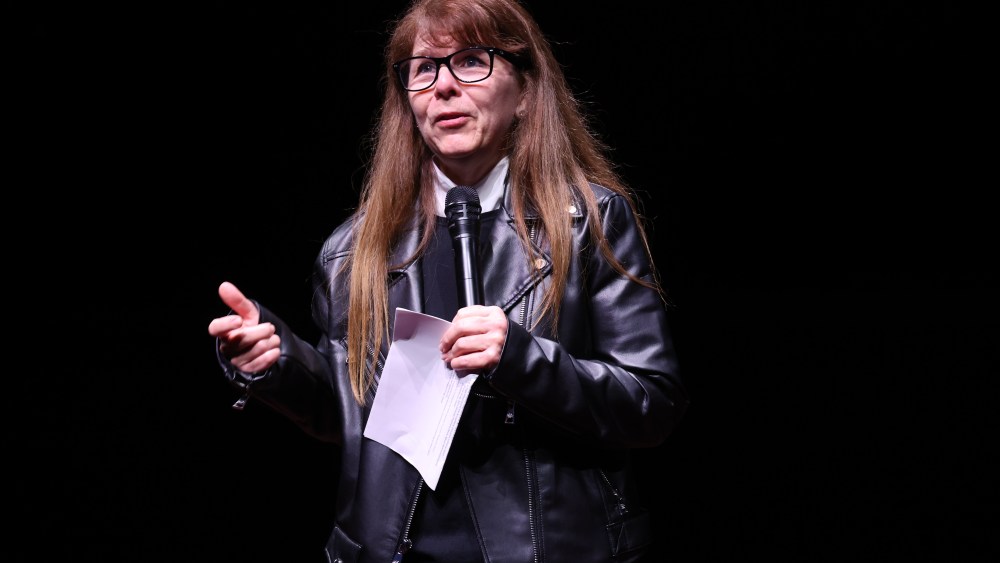Women Direct Only 11% of Global Films, Per USC Annenberg Study
Women comprise 11.6% of the directors of global films, according to a new study from the USC Annenberg Inclusion Initiative. The figure is among the indicators that women’s participation in the film industry at a global level is changing, but still nowhere near equality.
Dr. Stacy L. Smith shared results of the study on Monday during the University of Oxford Cultural Programme’s Women in Film event. (“Bridgerton” breakout Simon Ashley, “Surface” star Gugu Mbatha-Raw and Dr. Smith led the lineup at the daylong conference.) The report focuses on women’s progress across four areas of interest: as global film directors across 11 countries, at film festivals across six countries, as award recipients (for directors, writers and producers at the Academy Awards, BAFTAs and César Awards) and as film executives (at studios, distributors and subsidiaries in the U.S., the U.K. and France).
The study examines feature-length, narrative films that earned $1 million at the global box office and originated in 11 countries (Australia, Canada, France, Germany, India, Italy, Japan, Korea, New Zealand, the United Kingdom and the United States). A total of 4,532 movies were assessed and the gender of 4,991 directors was evaluated.
While no country was close to reaching the global population benchmark of 50%, the three countries with the highest percentage of women directors were Germany (18.7%), the United Kingdom (18.5%) and Australia (18.3%). The countries with the lowest percentage were India (4.9%), Japan (4.7%) and the Republic of Korea (9.1%). Women make up 11.3.% of the directors in the United States, which is on par with the average. The percentage of women of color in the director’s chair (5.7% in 2024) has doubled in the last decade (2.5% in 2015), but the figure is still in the single digits.
“For several years, we have examined the prevalence of women directors of top-grossing movies,” Dr. Smith said in a press release. “The results of this report demonstrate that there is still a steeper climb to the top leadership position in film for women no matter what country they work in. The encouraging finding across this analysis is that there has been change in some countries and particularly in the U.K.”
As Dr. Smith notes, Canada, France, Japan, the Republic of Korea and the U.K. demonstrated increases over the past 10 years. The U.K. saw the largest growth in the last decade; in 2024, 32.3% of its directors were women — a 6.6% increase from 2023 (25.7%) and 24% higher than 2015 (8.3%). Comparably, in 2024, 16.2% of U.S. films were directed by women, which is double the figure from 2015 (8.5%).
Unveiled just before the Cannes Film Festival begins on Tuesday, the report expands on research that Dr. Smith and Annenberg’s Katherine Pieper presented in April at an event highlighting the achievements of the Kering Women in Motion program. (That report surveyed 3,240 narrative films made in Australia, France, Germany, Italy, the U.S. and the U.K. that grossed at least $1 million globally and the lineups at five top film festivals: Cannes, Berlin, Venice, Sundance and Toronto. The new study surveyed five more countries as well as the London Film Festival.)
Across 10 years of programming at the six film fests, only 27.8% of narrative movies were directed by women. Sundance featured the highest percentage of women directors (34.7%), followed by Berlin (30.3%), Toronto (29.4%), London (25.9%), Cannes (21.6%) and Venice (20.5%). The study also breaks down the progress for women narrative directors at each festival by year, whether their films were shown in competition, a breakdown of representation by race/ethnicity and the prevalence of nonbinary directors.
The study also assesses women’s artistic recognition in the best film, director, original screenplay and adapted screenplay categories at the Academy Awards, BAFTAs and César Awards from 2015 to 2025 (11 years of nominations). Across all three awards bodies, women were most likely to be nominated in the best film category (26.7%), followed by original screenplay (24.1%) and adapted screenplay (22.5%). Only 14.8% of best director nominees were women (a gender ratio of 5.8 male directors nominated for every female).
Finally, the study examined 1,367 executives across film companies in the U.S., U.K. and France. Overall, 56% of executives were male and 44% were female. Parity was achieved in France, where 50% of identified executives were female, compared to 46.6% in the U.K. and 42.9% in the U.S. The study further explored the rank of executives, finding that women were most prevalent in senior VP (52%) roles in the U.S., while women filled 54.3% of VP/head/director roles in the U.K. and 70% of president-level positions in France. Women executives of color made up less than one-quarter (24.4%) of the tally across all three countries. Sixteen women of color held C-Suite level roles in the U.S., four of whom were specifically responsible for content creation.
“Overall, the results reveal that women have found ways to showcase their storytelling talent in a variety of places — but that they are still underrepresented relative to men,” the study concludes.
While the degree of this marginalization differs by country, film festival, award type and executive role, the authors note, women of color face the steepest challenges. “Across the analyses reported here, opportunities for women from underrepresented racial/ethnic groups remain less robust and these women remain less recognized than white women,” the authors write. “Our other work demonstrates that women of color often tell the most highly reviewed stories, so the continued exclusion of these storytellers reflects an ongoing industry bias that exists globally.”


